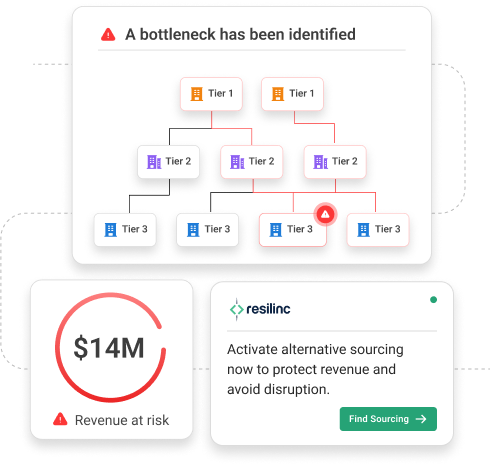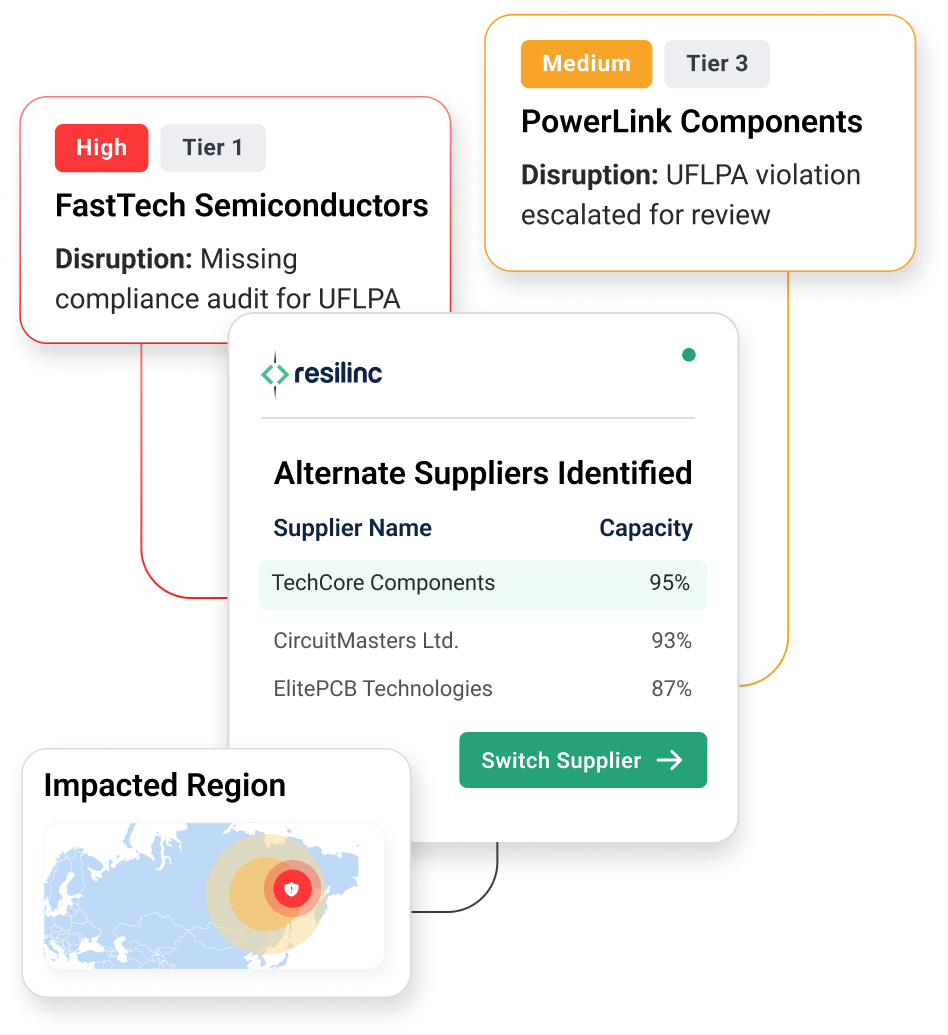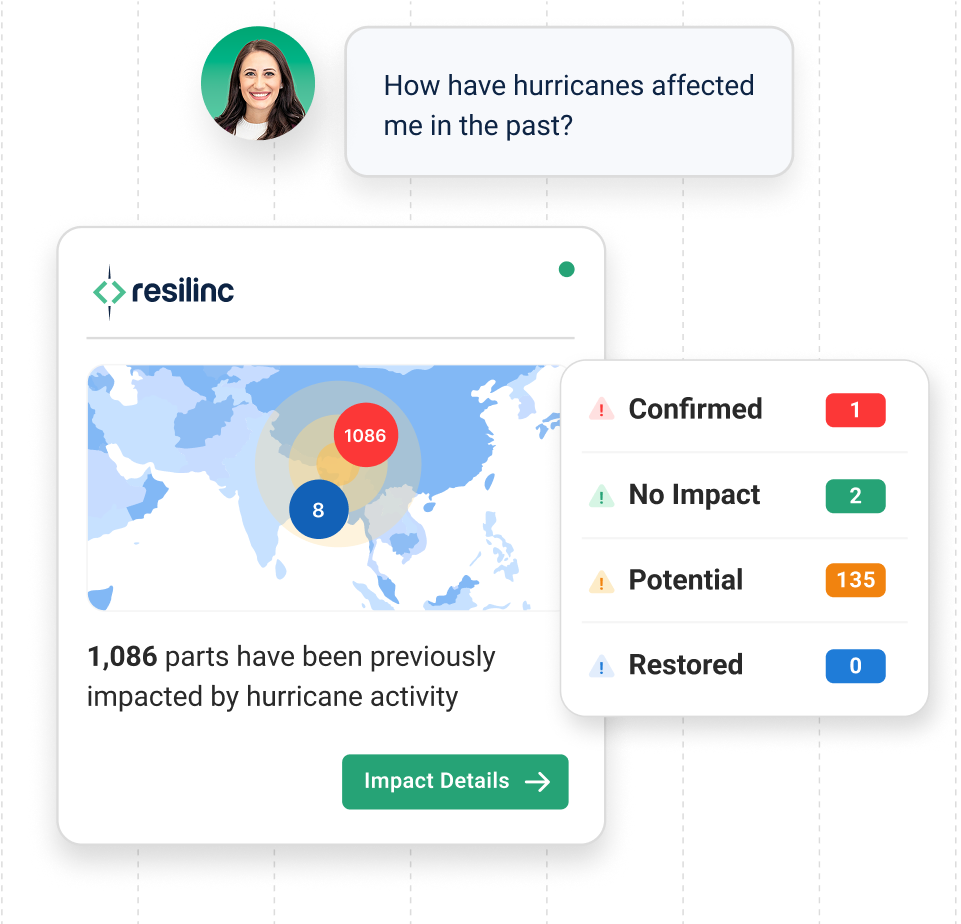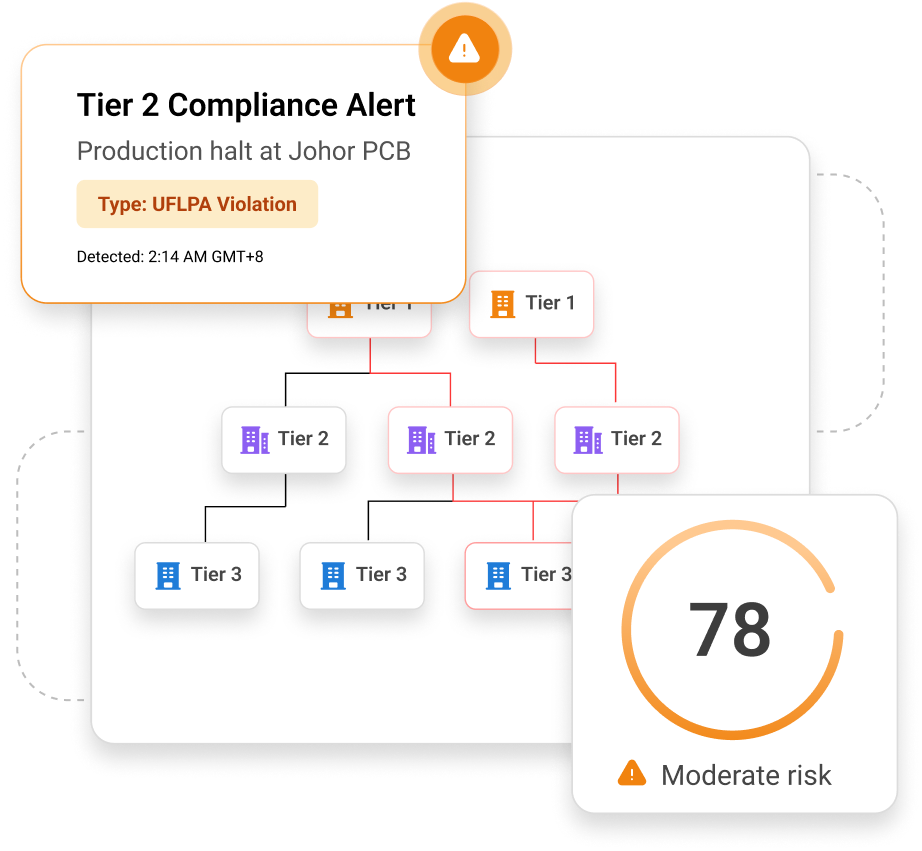What is supply chain risk management?
Supply chain risk management (SCRM) is the strategic process of identifying, assessing, and mitigating threats that could disrupt the flow of goods, materials, or services across your supply network. It encompasses both internal risks—like equipment failures or workforce shortages—and external threats such as natural disasters, cyberattacks, regulatory changes, or supplier bankruptcies.

The traditional approach
Why traditional supply chain risk processes fail
The modern approach
Why modern supply chain risk processes get results
Evaluating the data
Supply chain disruptions are escalating, and Resilinc's data shows it
Regulatory and compliance alerts surge
Compliance alerts rose sharply from early 2023 through early 2024, then climbed even further in the first half of 2025, highlighting intensifying regulatory scrutiny and increasing operational challenges across industries.
Factory fires persist
Factory fires remained the top disruption for the sixth consecutive year, driving shutdowns, insurance claims, and production delays across multiple industries.
Labor disruptions increase
Labor disruptions have intensified across industries, driven by workforce shortages, union actions, and shifting economic conditions, leading to widespread operational setbacks and financial strain.
Increasing shipments denied under UFLPA
Year-to-date in 2025, the U.S. Customs and Border Protection (CBP) has denied 83% of shipments—5,745 in total, representing over $55 million in value.
Assessing risk
Categories of risk—and why they matter
1. Internal risks
Equipment failures, labor shortages, IT outages, or cash-flow issues can halt operations. When a quality-control lapse triggered a recall, one manufacturing leader quickly identified affected batches and rerouted production, showcasing effective supply chain risk mitigation that prevented costly delays and protected their brand reputation.
2. External risks
Natural disasters, cyberattacks, pandemics, or trade wars can interrupt your supply chain. When Hurricane Maria hit Puerto Rico, companies without visibility couldn’t respond fast enough—but one global biopharma leader using Resilinc identified at-risk parts in four days and secured $1.5M in inventory, ensuring zero patient disruption.
3. Network risks
Poor coordination among suppliers, logistics, and partners can create major blind spots. After Fukushima, one automotive OEM discovered 6,000+ at-risk parts due to limited sub-tier visibility. With Resilinc, they reduced inventory buffers by 15% and improved response times.
4. Regulatory and environmental risks
Compliance failures, regulatory penalties, or sustainability violations can disrupt operations. Since 2022, over $2.6 billion worth of electronics have been flagged for forced labor risks under UFLPA, highlighting the importance of proactive monitoring.
Knowing the cost
What is the cost of not investing in supply chain risk management?
Average cost of a major supply chain disruption per year
30% of disruptions cost more than $5 million each; 16% cost more than $10 million each
Increase in global supply chain disruptions from H1 2024 to H1 2025
Understanding the benefits
The benefits of proactive supply chain risk management software
Reducing risk
How can organizations reduce their supply chain risk?
Resilient supply chains are no longer built on inventory buffers, multi-source strategies, and reactive firefighting. Today’s leaders use agentic AI-powered technology and real-time data to predict and prevent disruptions. Start with these 5 foundational steps.
Step 1: Autonomous Mapping
Map your supply chain beyond tier 1
Most companies have limited visibility past their first-tier suppliers. But sub-tier suppliers often represent the greatest risks, especially for critical components.
- Use autonomous mapping to gain visibility down to the part-site level. This enables faster impact analysis and targeted mitigation efforts when disruptions strike.

Step 2: EventWatchAI
Monitor global events in real-time
Disruptions are growing in both frequency and severity. Factory fires, strikes, geopolitical conflicts, and regulatory changes now happen daily, costing companies millions in lost revenue, delayed production, and damaged customer trust.
- Implement AI-powered monitoring (like Resilinc’s EventWatchAI) that tracks 150M+ news sources and categorizes alerts (e.g., labor disruptions, factory fires, cyberattacks).

Step 3: Risk mitigation
Build predictive and proactive supply chain risk mitigation
70% of supply chain disruptions are preventable with the right foresight. Proactive planning transforms risk from reactive to strategic advantage.
- Create scenario-based mitigation playbooks, simulate “what-if” disruptions, and enable automated AI-driven workflows to take early action (e.g., pre-order parts, secure alternative suppliers).

Step 4: UFLPA Agent
Strengthen regulatory compliance and supplier assessment
Regulatory pressure is rising across industries—forced labor (UFLPA), drug safety (FDA), and emissions (EPA) are just the start. Noncompliance can trigger product holds, shutdowns, or brand damage.
- Automate compliance tracking with intelligent agents like Resilinc’s UFLPA Agent that evaluate supplier adherence, collect documentation, and flag violations before they stall your supply chain.

Step 5: SCRM program
Establish a cross-functional SCRM program
SCRM maturity requires alignment across procurement, logistics, legal, compliance, and executive leadership. It’s not just an investment in a new SCRM platform, it’s an operational mindset.
- Formalize risk governance, train cross-functional teams, and build playbooks, metrics, and accountability. Use expert guidance to accelerate SCRM maturity—cutting timelines from years to months.

AI offerings
Agentic supply chain risk solutions
Resilinc’s Agentic AI Suite helps you outsmart disruptions with AI agents that monitor, analyze, and act—powered by 15 years of trusted data.
SC Watch
Foundational
Start with intelligent risk detection—powered by AI agents monitoring over 100M+ sources for real-time alerts and impact insights.
SC Monitor
Core
Advance to proactive risk management with predictive intelligence, tiered supplier mapping, and built-in disruption agent capabilities.
SC Command
Enterprise
Unlock full-spectrum control with enterprise-wide visibility, multi-tier simulations, and advanced scenario planning to drive resilient global operations.
Tariffs Agent
Track, assess, and respond to tariff and trade risks with smart, context-aware automation.
UFLPA Agent
Stay ahead of forced labor enforcement with AI-powered supplier screening and compliance.
Disruption Agent
Act faster with an intelligent agent that detects, prioritizes, and guides your disruption response.
See agentic AI in action
The next era of supply chain risk management will be defined not by how well organizations respond to crises, but by how intelligently they anticipate and prevent them. Schedule a free consultation to assess your SCRM maturity, explore our supply chain risk management software, and identify high-impact improvements.
